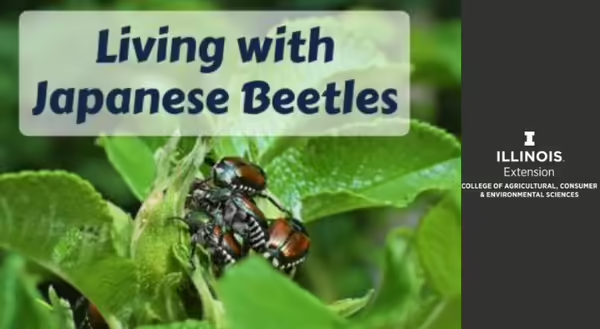
It's about that time of year, time for Japanese beetles...
Japanese beetles are one of the most destructive ornamental pests we have in Illinois. They were first discovered in the United States in 1916 in New Jersey and have been making their way across the U.S. since then. The adults are about a ½ inch long with copper-colored wing covers, shiny metallic green heads and prominent white tufts of hair along their sides. While the larva are c-shaped white grubs that can reach 1¼ inches long. Adults will feed on over 300 different species of plants and the larva will feed on turf roots.
Adults will typically begin to emerge in late June in southern Illinois and in early July in central and northern Illinois and will typically be around for about six weeks. Although, it looks like they may emerge sooner this year (depending on where you live). Some of their favorite plants include linden, rose, crabapple, willow, grape, and raspberry. Adults will begin feeding on the upper, sunlit portions of plants and work their way down. Their feeding damage can cause leaves to appear lacey and when feeding is heavy entire branches can be stripped of leaves. One of the reasons they are so destructive is that they are attracted to plants that have already been damaged. Because of this, large numbers of beetles can be attracted to susceptible plants and why if you can get on top of populations early you often have fewer problems in the long run.
There are several different things you can do to manage Japanese beetles.
- Adults can be removed by hand. The best time to do this is in the early morning while they are still sluggish. Put a few inches of water in a container along with a drop or two of soap (this is done to help break the surface tension of the water not kill the beetles). You can then shake or pick the beetles and put them in the bucket and drown them. This may be a great project for kids who love playing with bugs or while enjoying your morning coffee.
- High-value plants, like roses, can be covered with cheesecloth or other fine netting during peak beetle activity to protect them. Just make sure that the openings are small enough to keep the beetles out.
- Japanese beetle traps are not recommended for managing populations of Japanese beetles. The traps attract far more beetles than they can trap and may end up doing more damage than good. Don't believe me? Here are some pictures.
- Chemicals can also be used to help manage beetle populations (check with your local Extension office for the most up to date recommendations). For many of the chemicals, this will require several applications. When choosing a product, make sure that the site/plant that you plan on applying it to is listed on the label. Always make sure to read and follow all label directions!
- Controlling Japanese beetle grubs in your lawn won't have a significant impact on adult populations. The adults are capable of flying long distances and will fly in from adjacent properties.
- If you don't want to fight the beetles you can try growing plants that are unattractive to them. Yes, they do exist! Some of these plants include columbine, begonia, dogwood, forsythia, holly, impatiens, lilacs, hosta, and violets.
Want to learn more about Japanese beetles? Check out our webinar!
Signup for our emails! Want to get notified when new Good Growing posts are available? SIGN ME UP
MEET THE AUTHOR
Ken Johnson is a Horticulture Educator with University of Illinois Extension, serving Calhoun, Cass, Greene, Morgan, and Scott counties since 2013. Ken provides horticulture programming with an emphasis on fruit and vegetable production, pest management, and beneficial insects. Through his programming, he aims to increase backyard food production and foster a greater appreciation of insects.